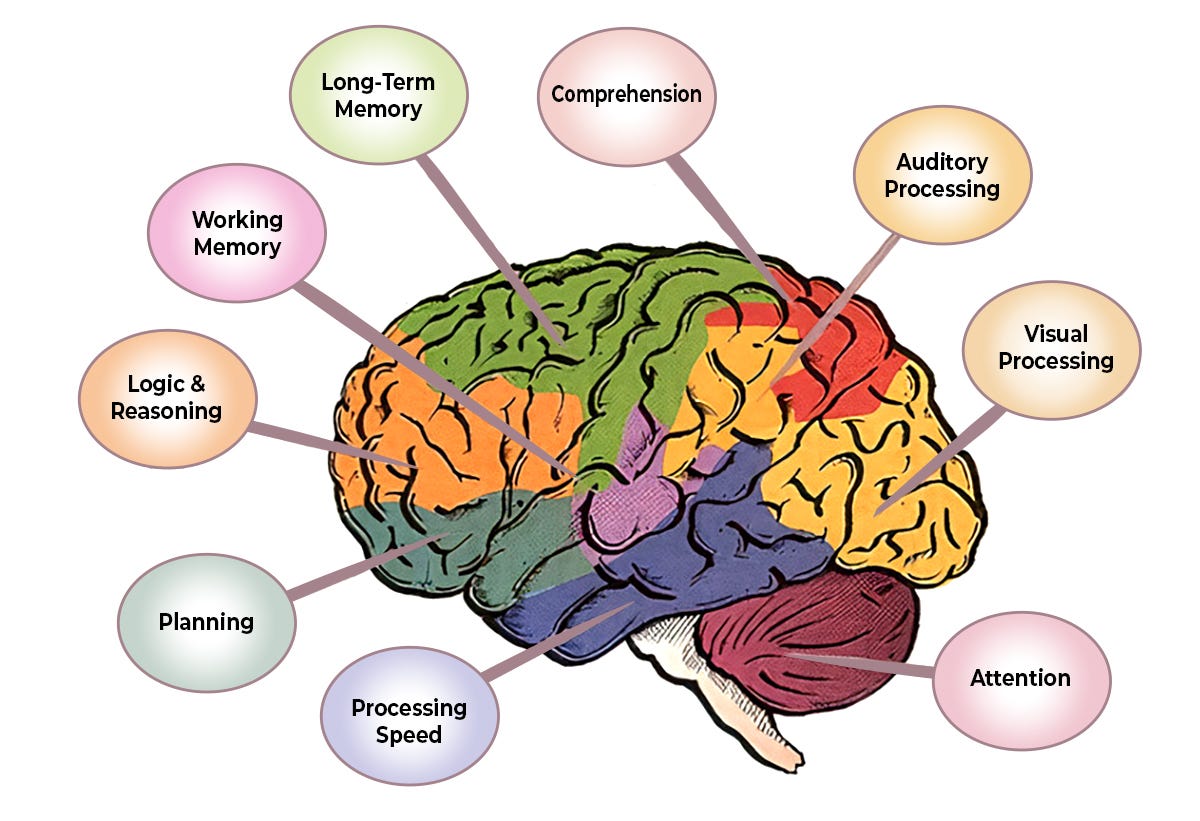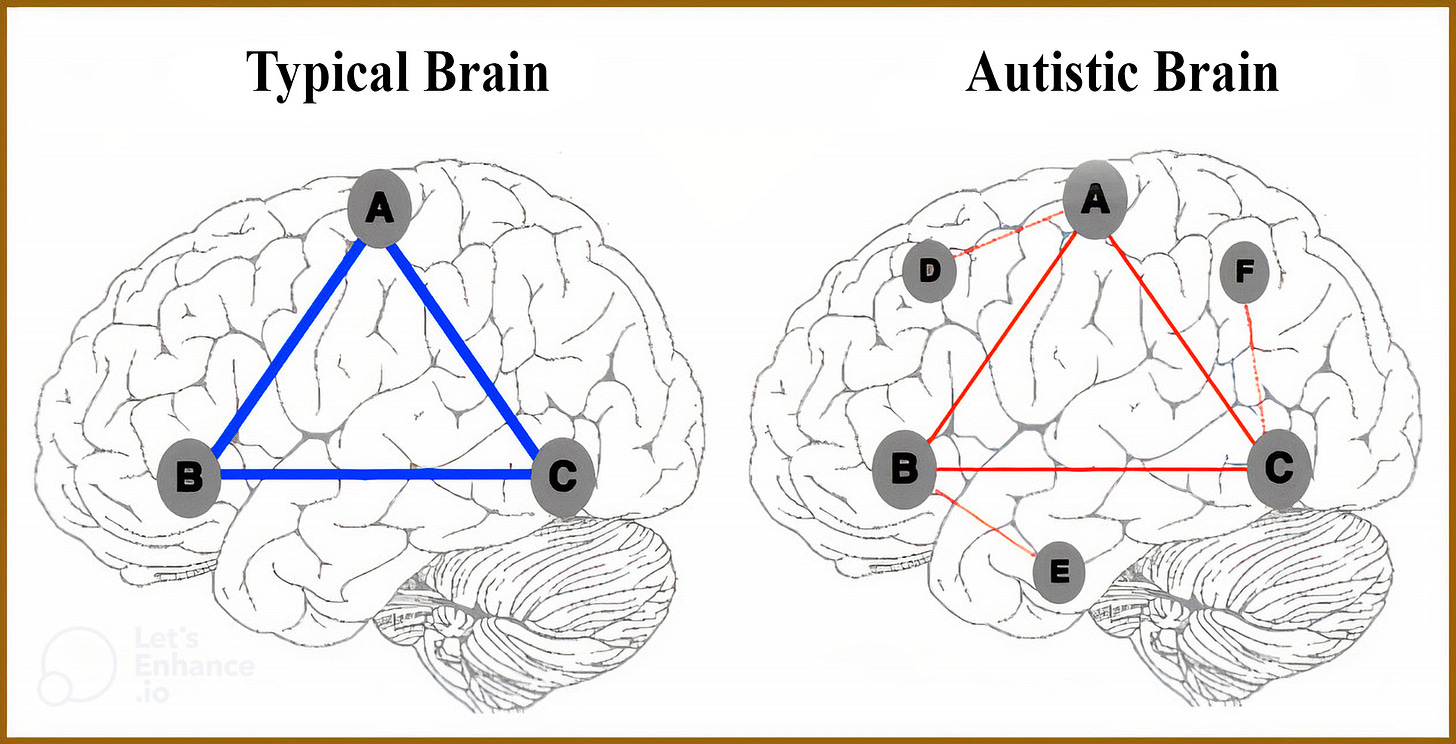The neurobiological condition of the autistic brain leads to cognitive differences. Which part of the brain supports which cognitive dimension is a topic of much technical detail. What is of interest for teaching pedagogies are the cognitive differences, these are explained by five psychological theories of autism. Using these, the teacher can unlock the learning personality of the autistic child. However, mere theoretical proficiency is not enough, the teacher must have the ingenuity for practical application. Teaching and parenting are the main instruments in any implementation plan.
A. Executive Dysfunction Theory
(i) Challenge: Executive Function (EF) is the ability to control action, attention and thoughts. EFs are important for every aspect of life: mental & physical health, school readiness and success, social development and quality of life. What are the main attributes of EF? Staying focussed, taking time before acting, working memory, inhibitory control or regulating impulses, interference control or the ability to ignore environmental stimuli while working, also called cognitive inhibition - these are the relevant EFs in the context of autism. Beyond this, there are other dimensions, like out of the box thinking, flexible adaptations or cognitive flexibility, mentalising ideas, understanding different perspectives, higher order skills like planning, reasoning and problem-solving. This requires following multi-step directions and combining information from several sources.
In autism there is a dysfunction of the EF faculty. A core feature of autistics, the inability to plan action and shift attention, is due to this. Repetitive behavior, adherence to routines, getting stuck, narrow interests and inability to multi-task are the consequences.
(i) Capacity Building: The inability to multi-task and restrictive interests lead to Monotropism or a flow state, where all other stimuli is inhibited and the attention is on a single focus. Even sensorimotor stims can be converted into skill development programs if the intervention planning is right. Autistics are creatures of habit – traditionally considered an anti-EF trait. However, this can be used to teach them impulse control like not grabbing some other child’s toy or the discipline to stay on task irrespective of distractions for a reward later. For motivation, a list of attractive stimuli related to the concerned child may be prepared. There is a tome of behavioural intervention literature on these strategies. Delay discounting, it is called by neuroscientists and learning theorists.
Teaching children how to wait improves their performance and also stimulates them to think, sometimes in novel ways. Teachers can also create a checklist of aversive stimuli and remove it from the environment to build attention. Removal strategies are routinely used by diet planners even for neurotypicals to promote inhibitory control. The focus has to be towards creating a perceptual pull towards learning and the neural system has to be trained for ignoring distractions. An example for the latter would be holding group lessons in different domains. Early training for inhibitory control is predictive of better learning outcomes and calmer family situations.
Working memory is another core EF. It means holding information in mind and mentally working on it. It also includes visual-spatial components. Autistics benefit from repeated trials of instructions, it helps them to translate it into actions, see the connections between unrelated elements and combine it into an integrated whole. A brushing protocol, for instance can be formatted and stabilised by assembling different items (Brush, Toothpaste, Mouthwash & Towel) to create a conceptual knowledge about brushing with perceptual inputs. This can settle into an ADL (Activities of Daily Living) plan. Visual cues help in the development of working memory, it also helps to promote inhibitory control, as the child focuses attention on the task rather than extraneous / environmental stimulus or distractions. Capacities can be cranked up by presenting two tasks and sequencing one after the other. Daily planners, checklists, and homework logs between teachers and parents are required supports.
Cognitive flexibility or shifting tasks, understanding someone else’s perspective comes much later because this requires loading working memory with new information. It is the opposite of rigidity. The teacher has to present the material in innovative ways and conduct many practice sessions. A posted schedule at home or in the classroom is very important. In addition, extra time must be allowed for autistic students to process directions, teachers need to give step-wise instructions, one step at a time, or repeat directions as needed.
Overall, EFs in autism can also get impacted by certain attendant conditions like stress, sleep disorders, loneliness and lack of physical exercises. These need to be addressed.
B. Weak Central Coherence Theory
(i) Challenge: Autistic people focus on small bits rather than overviews. This presents a challenge when information has to be integrated to arrive at a complete picture or a coherent gist. So, they are at a disadvantage at big picture tasks. Difficulties in generalizing information learned to different domains is also due to this.
(ii) Strength: However, the attention to detail and memory of those details is also a strength and leads to what Uta Frith calls, ‘islets of abilities’, rare skills in narrow fields of interest. If teachers act on what Frith calls, ‘a detailed focussed cognitive style,’ they can harness skillsets. Attention to parts and insistence on sameness, little attention to gestalt perceptions can be used for assembly line and detail-oriented work, visuospatial tasks like block design. For communication, it can be used to build functional vocabulary and leaving out additional or extra language. Therefore, an oft repeated teaching practice with autistic children is to use less words or to use keywords, they do not attend to additional language.
While presenting tasks to autistic children, teachers must be aware of the local versus global processing cognitive characteristic in autism. They must also be mindful that this is the reason for the tendency of the autistic child to fixate on visual stimuli or play with the wheels of the car instead of using the car as a toy. The child is not being naughty, inattentive or showing lack of understanding, he is simply demonstrating his cognitive preference. Weak Central Coherence (WCC) has to be supported by creating visual organisers and using guiding questions or gestures.
C. The Mind blindness Theory (ToM)
(i) Challenge: Known variously as Theory of Mind (ToM), mind-reading, mentalizing skills, autistics cannot understand or imagine people’s intentions or what goes on behind their gestures, body language or use of figures of speech and idioms. This leads to social communication and learning difficulties, even rudimentary tasks in early phases of looking and joint attention are tough and have to be taught. According to Prof. Francesca Happé, who specialises in cognitive neuroscience, it is possible that WCC may be related to ToM, because in order to understand the thoughts and feelings of another person in a real life situation, an individual needs to be able to take into account the social context and integrate diverse information from a variety of sources.
ToM is among the most researched theories of autism and was developed by Simon Baron-Cohen. The main postulate of this theory is an individual should be able to identify his/her mental states and that of others, and use this information to make predictions regarding others’ behavior. It is precisely this ability that is impaired in children with autism. This theory hypothesizes that impairments in taking the perspective of others results in many of the common deficits in autism, such as intentional communication, pretend play, and inferring others’ emotions and beliefs. This deficit is also termed ‘mindblindness.’
(ii) Capacity Building: Truthful, lacking pretension and deception, autistic children can be groomed to become an honest workforce by informed and motivational teaching methods. Explicit teaching regarding how to understand the emotions of others and how to solve problem in social situations is a necessity. Strategies such as visuals, role-play, or social narratives to remind individuals with ASD about emotional states or appropriate behaviors can be useful. In addition, parents and teachers working with autistic children should be careful about not characterizing atypical behaviors, or meltdowns as problem behaviors. The repercussions of these are not fully understood by that child. Rather consider the triggers for such behaviors, try to reduce or eliminate them and slowly teach the child an alternate social communication, also consider explaining how behaviors impact others or make others feel through a visual story method that may factor in emotional language content, basic words that convey feelings. The ABC (A-Antecedents, B-Behavior & C-Consequences) card may be used to create such datasets, it should be paired with a Good Behavior Card also for a holistic intervention approach.
D. Empathizing-systemizing Theory
(i) Challenge: Empathy deficits leads to autistic ‘aloneness’ or ‘aloofness’, making relationships and friendships very difficult. Lack of Empathy Quotient is very apparent in the social communication domain with difficulties in socio-emotional reciprocity. Parents find lack of emotional connectedness or its slow development, wrenching.
(ii) Strength: The other half of the theory indicates a strength, the drive for mechanical systemizing, sequence, adherence to rules and rituals, routines, preference for predictability. It is also known as the Extreme Male brain theory and can be used to settle healthy routines for the child in an array of domains: Daily living, Healthy eating, Sports, Vocational education, Teaching core vocabulary. All these activities require systemizing skills, are repetitive, sync with the insistence on sameness parameter and fit the narrow interests diagnostic criteria. If the drive to systemize is harvested, the world would become more predictable and therefore easier to negotiate for autistics.
However, the Intense World theory suggests that these social difficulties are caused by sensory hyper-reactivity and sensory overload, rather than empathy impairment or mind blindness. It is as yet not very clear how sensory reactivity relates to empathy and systemising, several researches are trying to understand this association. The findings will certainly reveal more about the autistic mind, its coping mechanisms, learning patterns and social preferences.
E. Magnocellular Deficit Theory
Postulates that deficits in visuomotor spatial integration, affects planning actions and attention. The visual system is divided into two subsystems: the magnocellular pathway (M-pathway subsystem) which processes visual stimuli and parvocellular which mediates motion and spatial details. In autism, the M-pathway is affected, while the latter is intact. Therefore, after presenting a task to an autistic child an extra response time is given. Many are investigating this theory and also if there is a lapse in co-activation of both sub-systems. Magnocellular processing is also implicated in Developmental Dyslexia.
Postscript
Autism theories should be used to understand the learning profile of a child, it should not be used merely to produce a bucket list of what a child cannot do. It should not also be used as a rationale for low targets, ambitionless teaching, rather it should be considered as a call to action.






It's opening our minds and Equping us to take action, to achieve the desired goal.
It's very practical, the parental perspective is evident.
This is what would building new knowledge and abilities to address the real needs.
Great connecting.
Regards
V S Basavaraju
Former state commissioner
RPwD act
Government of karnataka
Thanks for sharing 🙏